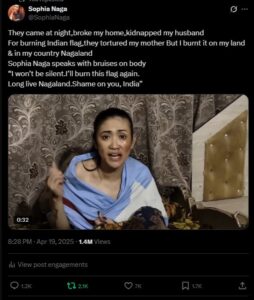A young Naga woman has alleged brutal sexual violence and custodial torture at the hands of Indian security forces following her viral protest against Indian rule. The woman, known publicly as Sophia Naga, gained widespread attention after posting a video to Twitter/X in which she is seen burning the Indian national flag and declaring: “This land is not India. It is Nagaland.” The video sparked national and international attention, with sharp divides in public reaction.

Watch her full video here
According to Sophia, days after the video went viral, soldiers raided her home at night, beat her severely, and subjected her to sexual violence. Her husband, she claims, was taken away and has not been heard from since. In a follow-up video released through the same social media channel, she described her experience with trembling composure: “They didn’t just hurt me. They wanted to break me. But I survived. And I will speak.”

The Indian government has not issued a formal response to her allegations. Independent verification remains difficult given the heavy militarization and restricted access in parts of Nagaland. Nonetheless, the incident has rekindled debates over India’s handling of the longstanding Indo-Naga conflict and its record on human rights in the Northeast.
Sophia’s act was not a spontaneous stunt—it was, as she put it, “a cry from generations silenced by fear.” Her reference was to the decades-long Naga struggle for sovereignty, rooted in history that predates Indian independence. In fact, the Naga National Council (NNC) had already declared Naga independence on 14 August 1947, one day before India’s own freedom from British rule. This historic declaration was followed by a 1951 plebiscite, in which an overwhelming 99.9% of Nagas reportedly voted for complete independence from India. The Indian state ignored the vote.
Subsequently, Nagaland was subjected to waves of military operations. In 1958, the Government of India passed the Armed Forces (Special Powers) Act (AFSPA), which gave soldiers broad immunity in “disturbed areas.” Human rights organizations, including Amnesty International and Human Rights Watch, have repeatedly condemned AFSPA as enabling systematic abuse. In Nagaland and other Northeastern states, the law has been blamed for extrajudicial killings, enforced disappearances, torture, and sexual assault.
One of the most well-known cases was the Oinam Incident in 1987, where Indian forces allegedly raped 27 Naga women and tortured hundreds of civilians during a counterinsurgency operation. Not a single official was held accountable.
Sophia’s case echoes these patterns. While some dismissed her story as “anti-national propaganda,” others—including Naga rights groups and student bodies—have come forward in support. Online campaigns under hashtags like #JusticeForSophia, #FreeNagalim, and #AFSPAAbuse have begun to trend across platforms, sparking international attention.
In response to critics calling her actions sedition, Sophia tweeted: “You call it sedition. I call it memory. I call it truth. My body carries the scars, but not shame.”
The Indo-Naga conflict is one of South Asia’s longest-running political struggles. The demand for a sovereign Naga homeland—sometimes referred to as “Greater Nagalim”—has existed since before India’s formation. Successive Indian governments have signed multiple ceasefires and framework agreements, including the 2015 accord with the National Socialist Council of Nagalim (NSCN-IM), which recognizes the “unique history and situation of the Nagas.”
Yet a permanent political solution remains elusive. Talks have stalled over key issues such as a separate Naga flag and constitution. Meanwhile, military presence and surveillance remain high in many Naga-dominated regions.
Sophia Naga’s protest and subsequent ordeal have put an international spotlight back on the region. Human rights groups have begun issuing calls for an independent investigation. In the words of one international observer: “If even peaceful dissent is punished with this kind of brutality, what kind of democracy is India claiming to be?”
As of now, Sophia’s whereabouts remain undisclosed for safety reasons. Her supporters say she is under constant threat. Despite this, she released one final statement: “I burned a flag. But India burned my home, my dignity, and my voice long before that. I speak for all those who can’t.”
This is a developing story.
